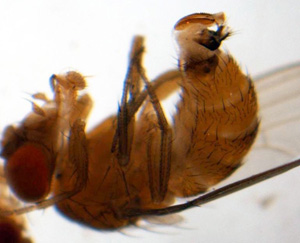Celebrate National Vinegar Day by Using Vinegar...to Trap This Invasive Fly
 |
|
Spotted wing drosophila in the laboratory. Source: Hannah Burrack, North Carolina State University, Bugwood.org |
New Year’s Eve is a time to reflect on the past year and it usually involves good food. December 31 is also National Vinegar Day and if you have an interest in good food, you probably have vinegar—which has been used for 10,000 years and just might be the world’s oldest ingredient—in your cupboard. If you have any raspberry-infused vinegar on your shelf, you might already know about the invasive spotted wing drosophila and how raspberry growers are worried about it.
Spotted wing drosophila (SWD) is a small “vinegar” fly about three millimeters in length. It is called a vinegar fly because it has an affinity for the potent liquid associated with fermenting or rotting vegetable matter. Scientists believe the insect, once native to Eastern and Southeastern Asia, was transported unintentionally to the US. They estimate the invader is causing millions of dollars worth of damage to many of the fruits found in grocery stores and roadside markets during the summer and fall, including cherry, plum, and nectarine.
This insect has researchers concerned because unlike its native counterpart it damages healthy fruit still on the tree or bush, rather than overripe and decomposing fruit. Unsuspecting consumers could find tiny worms emerging out of ripe strawberry, raspberry, blueberry, or late-season peach.
Cornell University’s Northeastern Integrated Pest Management Center funded the SWD Working Group to find sustainable and science-based strategies to manage the insect. The Center promotes integrated pest management, an approach to dealing with pests that brings environmental, human health, and economic benefits.
Richard Cowles, an entomologist of the Connecticut Agricultural Experiment Station and member of the SWD Working Group, has come up with a way for growers and others to trap SWD. He uses two-liter plastic bottles cut in half and baited with kombucha, a fermented beverage made with sugar and vinegar. Kombucha, which likely originated in China, is composed of water, sugar, white vinegar, and a SCOBY (symbiotic community of bacteria and yeast) that can be inexpensively obtained online. The ingredients are mixed carefully and held in a warm location for one to two weeks. The kombucha has aged appropriately when it is effervescent and has an aroma reminiscent of apple cider that has started fermenting.
The two-liter bottle trap that holds the kombucha is a “major advance,” according to Cowles. The starting materials are inexpensive, the trap is relatively easy to make, and having the opening at the bottom of the trap is compatible with use of insecticide and sugar-baited sprays for those using an attract-and-kill program.
For more details, see the Northeastern IPM Center website:
— by CHRIS GONZALES
The Northeastern IPM Center promotes integrated pest management for reducing risks to human health and the environment. If republishing our news, please acknowledge the source (“From Northeast IPM Insights”) along with a link to our website.
